Our Boomsday Project OTK Paladin deck list guide will help you learn how to better pilot this deck. Our guide features mulligan, play, and card replacement strategies!
Introduction to OTK Paladin
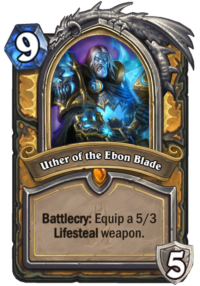
First OTK Paladin theorycrafts popped out even before Knights of the Frozen Throne expansion was released. One of the Hero cards – Uther of the Ebon Blade – had a massive potential, but it turned out to be weaker than suspected. Or, let me rephrase it – while the card itself was good, the Paladin’s Control shell was too weak to make it work. Before Gadgetzan has rotated out, multiple players have attempted to make it work. Back then, it was all about getting extra Coins with Burgly Bully as a set-up and then doing a “real” OTK turn with Auctionmaster Beardo. It wasn’t too strong, and the idea was scrapped anyway after those cards have rotated out.
More recently, however, Thijs has brought the deck back to live. Not only he did a few high Legend finishes on his stream (peaking in top 10 a bunch of times), but he also brought it to the Hearthstone Global Games as a part of team Netherlands. While it’s certainly not the best deck on the ladder right now, between the surprise factor (because players usually mulligan vs Odd Paladin) and it consistently beating slow, grindy decks, it makes quite a lot of sense to run it in certain metas.
Boomsday Project OTK Paladin Deck List
OTK Paladin Mulligan Guide
VS Fast Decks
Higher Priority (Keep every time)
- Righteous Protector – The only 1-drop in your deck, it should be able to trade well into many of the early game stuff your opponent drops, and it will definitely be annoying to get rid of.
- Plated Beetle – The best 2-drop you can have against Aggro – 2/3 stats are solid and the extra Armor does come handy in the long run.
- Truesilver Champion – Since minion-wise your early game is pretty weak, you will always end up behind on the board. Truesilver lets you climb back into control by clearing two minions (and healing for 4 while doing that).
- Call to Arms – Even after the nerfs, Call to Arms is still a very powerful card. It will usually pull out 5 mana worth of minions among 3 bodies AND thin your deck considerably.
Lower Priority (Keep only if certain conditions are met)
- Wild Pyromancer – Keep with Coin or Equality. By itself, it’s usually a vanilla 3/2 when you drop it early, since you have no cheap spells to combo with. But with Coin, you can deal 1 AoE damage on demand, and with Equality you have one full board clear available anytime you want, which is great against decks like Zoo Warlock or Odd Rogue, who can snowball the board.
- Gluttonous Ooze – Against weapon decks, e.g. Odd Rogue.
- Consecration – Consecration is an interesting case, because 3 health minions are very popular in the early game. Some decks run more of them and some less. You keep it vs Warlock (if you suspect Zoo) or Paladin (if you think it’s Odd or Even), but don’t keep it vs Rogue or Mage even if they’re Aggro, because most of their early minions have 3 health or more.
- Uther of the Ebon Blade – If the rest of your hand is okay-ish, e.g. you have a 1-drop or a 2-drop already, or at least a Truesilver Champion. You don’t need Uther for the OTK, but he’s an amazing comeback card vs Aggro – if you can survive that long, he will heal you for 20 in total over three turns, with the initial burst of 10 healing (5 Armor + 5 from the weapon) being incredibly relevant vs faster decks.
VS Slow Decks
Higher Priority (Keep every time)
- Loot Hoarder – Vs slower decks, you won’t be under that much pressure, so you want to draw the cards.
- Stonehill Defender – It’s a solid 3-drop – it’s usually too slow vs Aggro, but vs Control you can drop it on T3 instead of doing nothing, and you can even get an extra big Taunt to further stall the game.
- Prismatic Lens – The deck has limited card draw, and you want to keep yours vs slower decks.
- Call to Arms – One of the best cards in your deck vs slow decks – not only it creates a nice board presence AND thins your deck by 3 (incredibly important, since you want to draw your combo pieces as soon as you can), but it also consistently pulls out more card draw.
- Uther of the Ebon Blade – Your main win condition, you don’t want to risk it being one of the last cards in your deck, so you want to keep it in your opening hand every time.
Lower Priority (Keep only if certain conditions are met)
- Wild Pyromancer + Equality combo – Against certain decks such as Even Warlock (keep it vs Warlock in general, since it’s good combo vs Zoo too) – they might put a lot of power onto the board in the mid game and you might just die before even getting to the Uther.
- Gluttonous Ooze – Vs weapons decks, it’s always good to destroy one while gaining Armor and putting small body onto the board.
OTK Paladin Play Strategy
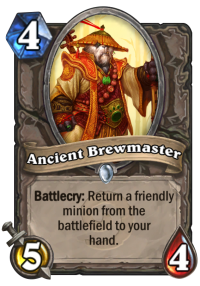
The deck’s main win condition is the OTK Combo, which is possible thanks to the Uther of the Ebon Blade. Once you summon four different Horsemen, you instantly win the game, even if your opponent has hundreds of Armor stacked or Ice Block up. But since you can only press Hero Power once per turn, normally it would take four turns to do it, assuming that your opponent doesn’t clear the Horsemen – not only it’s no longer an “OTK” then, but it’s nigh impossible that they will stick to the board. So what you need to do instead is bounce them back to your hand and then drop them all on the same turn.
You have three cards that let you bounce or copy them – Zola the Gorgon and two Ancient Brewmasters. But you need to be really careful – in order for the combo to work, you can’t have ANY four Horsemen, you need to have each one of them (they’re four different tokens). When you press the Hero Power, you can’t get a duplicate of the one that is already on the board, but it doesn’t count the hand. Let’s say that you rolled Darion Mograine first and bounced it back. Next turn you can roll Mograine again – if that’s the case, then you DON’T want to bounce it, since having a second copy will be useless. It makes your combo a bit RNG, and if you get unlucky, you might keep getting the same minions you already have in your hand.
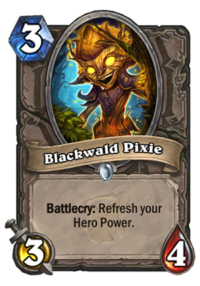
The most common OTK is just getting three of them in your hand, then dropping them all on the board and pressing Hero Power again – congratulations, you win the game! But there are also some easier ways to do it that come up from time to time, and they involve Blackwald Pixie. The card lets you use your Hero Power a second time, making it obviously much easier to get all four on the board at the same time. If you’re playing vs a slow deck, you might want to keep your Coin instead of using it (unless you really have to). Having the Coin and Pixie lets you OTK your opponent with just two Horsemen in your hand. You drop them on the board, play Hero Power, Pixie, Coin and Hero Power again. The entire combo costs 11 mana, and that’s why you need your Coin (alternatively, if you draw Pixie and Equality from your Prismatic Lens, then it’s also possible). If you haven’t started with Coin or couldn’t afford to save it, you can still utilize Pixie. If you manage to stick a single (yes, just a single) Horseman to the board and have a different one in your hand, Pixie lets you perform the combo too. Drop the one from your hand (now you have two), play Hero Power, Pixie and another Hero Power. The entire combo costs 9 mana, so you don’t need the Coin, and you can really surprise your opponent. While it comes down less often, probably the most obvious way to use it is having two Horsemen on the board already, then Hero Powering to get the 3rd one, dropping Pixie, Hero Powering again and finishing the game that way. Although while one of them might sometimes stick, it’s very rare that your opponent will let you stack two of them.
As you can see, there are a few ways to combo the opponent down, and it’s actually not that hard. What is hard, however, is surviving that long and drawing all of the combo pieces. The main problem with this decks is that you can START gathering the Horsemen in your hand only after you turn into Uther of the Ebon Blade, so in a normal game, you can’t do it before Turn 10. This is the hard part. In the early/mid game you need to not only draw as much as you can (to actually get your Uther, as well as Brewmasters / Zola), but also stall the game. The job is not that hard vs Control decks, since they don’t put that much pressure, but it’s incredibly hard vs Aggro. That’s why in general, when you play vs Aggro, you just drop the OTK potential and play like a Control deck. You want to clear the board, put up the Taunts, get out of range of their burn damage. Ideally you want to play on the curve and try to keep up with them, but comparing your deck to theirs, it’s obvious that it won’t work very well, so you need your comeback tools.
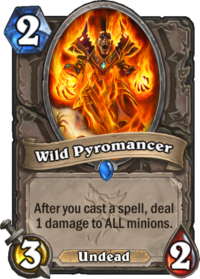
Consecration is the most basic AoE you run, and while it’s incredibly useful against Aggro, it often doesn’t cut it. The problem is that so many early game minions Aggro decks drop right now have 3 health and not 2. Just look at the Odd Rogue list, for example, and see how many of their 1-drops and 3-drops get cleared by Consecration. The answer is two – Southsea Deckhand and Fire Fly. Cards like Dire Mole, Vicious Fledgling, SI:7 Agent, Blood Knight, Void Ripper, Blink Fox and so on and so on aren’t killed by Consecration. Even Argent Squire isn’t thanks to the Divine Shield. That’s why, very often, you need something extra, and that’s where Wild Pyromancer comes handy. There are two main ways to utilize him. First of all, he combos with Equality, which is a nearly full board clear (it doesn’t clear minions with Divine Shield, but that’s all). You only run two Equalities in your deck, and there’s a high chance that you won’t draw both of them vs Aggro, so the timing is very important. You want to use it only when your opponent puts enough pressure and when you can’t answer it in other way. Shrink Ray is an alternative to Equality, it can also be combod with Pyromancer for a full clear, but it’s much less useful vs Aggro, since it costs 7 mana instead of 4. You can, however, use Shrink Ray by itself to reduce the amount of damage on the board. E.g. you if you can shave off 5-6 damage from the board, as well as lots of health, then it’s worth it. Wild Pyromancer can also be used simply to deal 1 extra AoE damage – you can combo it with some spell (even with Coin) to deal 1 AoE, but the best combo other than Equality would probably be the one with Consecration. It ups the damage to 3 and leaves a 3/1 body on the board to contest whatever your opponent might drop next turn.
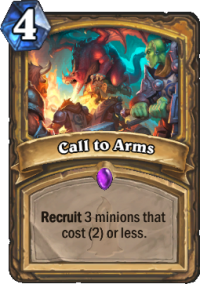
Call to Arms play a vital role in the deck, despite it not being as strong as it once was at 4 mana. What most people don’t realize is that it basically DRAWS three small minions on top of playing them. You get them out of your deck, you thin it by 3, which is amazing. Paladin is a class with very limited card draw, and it really shows. But Call to Arms doubles up as one on top of being a board presence tool. The fact that 3 out of 9 cards you can pull from it draw (Loot Hoarder and Bloodmage Thalnos) makes it one of the most important cards vs slow decks – it lets you get through your deck much faster. Removing those small minions from the draw pool also means that you have a higher chance to get the second Call to Arms or at least Prismatic Lens.
Crystalsmith Kangor is also an interesting card, because it’s pretty good despite this deck not running that much healing. By itself, given that it has Divine Shield and doubles his own Lifesteal too, he will usually heal for 4 on top of the 1/2 body with DS. That’s quite good vs Aggro. But if you can play him later, or it survives that long, it also doubles the healing from Truesilver Champion – it might not seem like much, but getting +4 instead of +2 is quite powerful when every point of life matters. Even later in the game, it can be combo’d with Uther of the Ebon Blade‘s weapon, which adds +5 healing to every hit, but to be honest, most of the time Uther is already a lot of healing and you rarely keep Kangor that long.
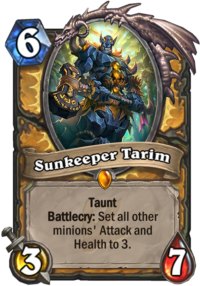
The last card I want to talk about is Sunkeeper Tarim. It’s obviously not as strong as in aggressive Paladin decks, but it’s still amazing in many scenarios. First of all, it can be used to answer a single big threat. For example, if Warlock drops a Mountain Giant, you can just play Tarim and turn it into a 3/3. Unless it gets Silenced, you have a great trade. It curves out right after Giggling Inventor – especially in slower matchups, it’s very likely that some of the small bodies survive, so just for the pressure alone, it might be worth to turn them into 3/3’s. That’s how I actually won a game or two without Uther, because it creates a massive board presence. Even if it won’t win you the game, it will keep your opponent busy for a while. Also, even if you have no board and you still want to drop Tarim, remember to press Hero Power or drop a small minion (e.g. Righteous Protector or Crystalsmith Kangor) first before using Tarim. Normally, if your opponent has three minions and you have none, Tarim is usually not that great (unless those minions are really big). But if you can e.g. drop Protector + Hero Power and then Tarim, now you have a board lead.
OTK Paladin Card Substitutions
OTK Paladin is a rather expensive deck, and many of the cards can’t be replaced, as they’re a part of the main combo. Still, I’ll take a look at each expensive card in the deck and try to offer some replacement if possible.
- Bloodmage Thalnos – It’s just played for the card draw, you can replace it. I’d probably use a second Plated Beetle, but you can try out a more expensive card draw instead, such as Gnomish Inventor,
- Crystalsmith Kangor – Again, Plated Beetle would be the best replacement, unless you’re already running two. You can’t remove too many of the low cost cards, because your Call to Arms won’t be consistent enough. If you’re running two Beetles, Vicious Scalehide would be the second best replacement.
- Zola the Gorgon – Zola is necessary. You could technically replace her with Youthful Brewmaster, but there is a significant risk of pulling it out with Call to Arms.
- Sunkeeper Tarim – Tarim is just a great Paladin card in general. There is no direct replacement, but for the Control purposes, you might try a second Shrink Ray instead.
- Uther of the Ebon Blade – Your main combo card, the deck basically doesn’t exist without it.
- Gluttonous Ooze – If you need weapon destruction, normally Acidic Swamp Ooze is a solid replacement, but in this case, you can pull it out with Call to Arms, making it not very consistent. Alternatively, you can try out Harrison Jones (but that’s Legendary), Corrosive Sludge (but that’s pretty bad), or drop the weapon destruction and play Aldor Peacekeeper instead.
- Prismatic Lens – Paladin really needs card draw, and while drawing 2 for 4 is not amazing, it’s the best thing you have other than Call to Arms. Still, it’s not absolutely necessary to play the deck – you can replace it with a more generic card draw, such as Gnomish Inventor. You could also try out Lay on Hands, but that’s a bit too slow.
- Call to Arms – I’d say that Call to Arms can’t be replaced, it’s a very important part of the deck. Not having Call to Arms will usually delay your combo by at least a turn or two, sometimes even more, because instead of drawing your Uther or the bounce cards, you will end up drawing your small minions that you normally would have pulled out of your deck with CtA.
Leave a Reply
You must be logged in to post a comment.

Not the best win rate but really fun to play. Its really good against other control deck. Thanks!!
“you don’t need uther for otk…” wut…
for aggro u dimwit. u just need to survive the early game vs. aggresive decks. don’t need otk condition for that
Read the context, don’t pull a random sentence from the guide.
You don’t need Uther for OTK VERSUS FAST DECKS, because you won’t likely pull it off anyway. You want Uther for the weapon and Armor gain, which is 20 healing (and 15 damage) in total.